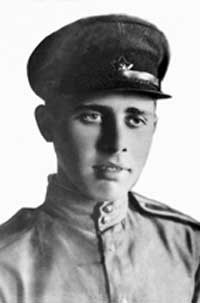Mikhail Avgustevich was born in 1924 in Saratov, in southern Russia. He was named Mikhail after his maternal grandfather Moisei Iakerson. (Since they lived in Saratov with its sparse Jewish population, his parents were afraid of giving their son the first name Moisei (Moses) so they replaced it with the Russian name Mikhail – a usual tactic of Jewish parents in Russia at the time). In any case, his parents called their eldest son by the nickname "Mosie." Mikhail was a pugnacious fellow and the main bully in his neighborhood. Together with other boys from his "lower quarter" of Saratov, he fought against boys from the "upper quarter." His mother Dvosia was afraid of her son's "bad company." Aware that his comrades tended to find work at the Saratov river port, she found work for Mosie at the more reputable agricultural machine plant "Kombain."
With the beginning of the Soviet-German War in June 1941, "Kombain" was transformed into a military plant. It was the only plant in the Soviet Union that produced the IAK-1 and IAK-3 fighter planes. Mikhail worked on the conveyor belt for assembling fuel tanks. The working day was originally 10-12 hours per day, but during the winter of 1942-1943, during the Battle of Stalingrad (which was only 360 km. / 225 miles south of Saratov), the working day was extended to 16 hours. Since the workers slept near their machines, Mikhail's mother brought food to him at the plant.
One day, after a night-long stay at his parents' home, Mikhail was late for work. According to a 1940 law (which, it should be noted, preceded the beginning of the Soviet-German war), being late by as little as 15 minutes was regarded as a criminal offense punishable by court-martial. Although Mikhail's sadistic supervisor let him continue working in his department, he constantly threatening to have him put on trial. A week later Mikhail met his father, who also worked at a military plant, and asked him to contact a close acquaintance at the recruiting office and ask him to accept Mikhail as a volunteer in the Red Army. Several days later Mikhail climbed over the fence of his plant and went to the recruiting office, where he was drafted and, thus, avoided being court-martialed. (According to his younger brother Semion, Mikhail's motivation was different: he supposedly said, "All our boys are at the front, while I, their ringleader, am riveting iron here"[1]). In any case, Mikhail arrived at the recruiting came to recruiting office without any identity papers and, in response to the question about his nationality [i.e., ethnicity], he responded "Russian".
Since Mikhail became a cadet at the tank school situated in the city of Saratov. For a while, he maintained contact with his younger brothers Ilia and Semion and with his parents. However, in the fall of 1943, the young tankist was sent to the front. He fought in western Russia, then took part in Operation Bagration, the liberation of Belorussia.
In March 1944, close to the village of Krasnitsa, near Mogilev in Eastern Belorussia, Mikhail's tank crew was sent on a reconnaissance mission. Since such a mission was fraught with danger, his chances of survival were close to zero. Indeed, Mikhail's tank was hit and he was killed.
Dvosia refused to believe that her Mosie was dead and wrote letters to the commander of his unit. In response, she received a package containing his documents. Until her last day she believed that Mosie's death was her fault since she had not succeeded in dissuading him from volunteering. She was also upset to learn from her son's military papers that he had been registered as a Russian.
Mikhail Avgustevich was buried in a common grave in Krasnitsa. After the war, his brother Ilia affixed Mikhail's photograph to the monument erected over the common grave.
Mikhail's youngest brother Semion Avgustevich (who was born in 1937) is the editor-in-chief of a leading Russian Jewish journal Korni – Roots – Vortseln – Shorashim.
[1] Semion Avgustevich, "Leitenant Moisei Avgustevich, russkii, 1944", Korni, 25 (2005), p. 65.







